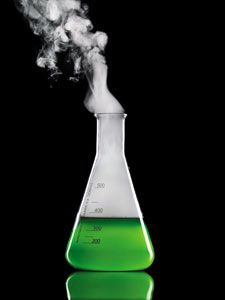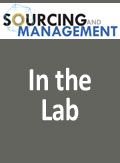Hazardous Reagents for Higher Yields
PTSM: Pharmaceutical Technology Sourcing and Management
Hazardous reagents can prove to be faster, simpler, cheaper, and greener.
Henrik Sorensen/GETTY IMAGES

The ultimate goal in pharmaceutical manufacturing is to achieve complex syntheses in high yields with high selectivities in as few steps as possible, and to meet quality requirements. Many reagents considered hazardous due to their extremely high reactivity and/or toxicity can often be used in processes that meet these criteria. In the past, however, the safe handling of such materials and the design of safe processes using them have been a challenge. Advances in engineering control and reactor/process technologies combined with greater understanding of the underlying fundamental physical and chemical behaviors of hazardous reagents are leading to their increasing use for pharmaceutical production.
Many options for improved processes
Reagents are typically classified as hazardous if they are highly unstable and/or react violently under specific conditions, such as exposure to oxygen or moisture in the air or when combined with other reactive species. Explosive compounds and substances that are sensitive to shock, friction, and heat are examples of unstable, hazardous reagents. Reactions that produce or use these compounds as raw materials, as well as highly energetic processes, require precise and careful control of the process conditions, including the use of inert blanketing gases, selection of the appropriate order and rate of addition, and maintenance of suitable reaction temperatures. Some toxic reagents also fall into the hazardous reagent category, such as extremely strong acids and bases and other corrosive materials.
Key examples of hazardous processes that have applicability for the synthesis of pharmaceutical intermediates and APIs include:
- Azide chemistry
- Carbonylation
- Carbon disulfide chemistry
- Cyclopropanation
- Diazomethane chemistry
- Diborane chemistry
- Halogenation
- Hydrazine chemistry
- Oxidation using O2
- Ozonolysis
- Nitration.
Of these technologies, halogenations, nitrations, and azide-based reactions are the most commonly performed hazardous reaction processes, according to Thierry Durand, R&D director at Novasep Synthesis. “These reactions are the most prevalent because they provide access to a large variety of functionalized aromatics and heterocycles that are present in many APIs,” he notes.
Many potential benefits
Although the natural reaction to the concept of hazardous reagent chemistry is to assume that such processes will be more complex, costly, and lead to complex mixtures of products, the opposite is often true. Hazardous reagents often allow the synthesis of desired compounds in fewer steps than more conventional reagents. In addition, the reactions often proceed more rapidly with higher yields and greater selectivities than can be achieved using multi-step routes with less reactive materials. “Overall, the use of hazardous reagents often leads to more cost-effective processes that provide purer products, and in fact as many as 10 of the 12 principles of green chemistry (1) can be fulfilled for these transformations,” Durand asserts. He adds that careful evaluation can lead to the development of short and elegant synthetic routes using hazardous chemistry that have reduced environmental impacts.
Realization of these benefits within the pharmaceutical industry is leading to greater interest in hazardous chemistry routes, particularly for the production of non-regulated raw materials and intermediates. Durand does note, however, that cGMP requirements are becoming more common for starting materials and earlier intermediates in overall synthetic schemes for APIs than even a few years ago, which can be a challenge to using hazardous chemistry for some pharmaceutical companies.
“Regulatory and supply chain risk management by pharmaceutical manufacturers requires alignment of the technologies used by multiple partners in their supply networks, often to the most standard technologies. Because specialized technical expertise is necessary for safe operations using hazardous reagents, many contract manufacturers do not have extensive capabilities in this chemistry. Some pharmaceutical companies therefore choose not to take advantage of the benefits offered by this technology,” he explains. On a positive note, however, there are many examples of the use of azide chemistry in the final steps of API syntheses. In addition, recently developed azide building blocks are now used to perform click chemistry to modify a large variety of biomolecules.
Real evidence
Novasep has been using hazardous reagents for more than 135 years and in that time uncovered many examples where hazardous chemistry offers significant advantages over more conventional synthetic methods. For instance, a recent process for the reduction of a hydroxy ester using a standard ester-reducing agent that originally involved five steps--including protection and deprotection of the hydroxyl group and provided the desired product in 59% yield--was replaced with a two-step route that proceeded via direct amide formation and gaseous diborane reduction (no protection/deprotection required) in 81% yield. Production costs were reduced by 60%, and the reaction using hazardous reagents proceeded with much higher atom efficiency, a lower E-factor, and the use of less solvent.
In a second recent example, a multistep Grignard/carboxylation process was replaced with a one-step carbonylation reaction. The customer required conversion of an aryl chloride bearing a keto substituent to an aromatic ester. The original process involved three steps, including protection of the keto functionality. The new process developed by Novasep involved Pd-mediated carbonylation and provided the desired product in quantitative yield without any need for a protection step. In this case, raw material consumption was reduced by 50% due to the high atom efficiency of the transformation and reduced solvent use.
Choosing the right hazardous reagent
Realization of such dramatic benefits does require extensive experience with hazardous reagent chemistry. Not all processes that at first glance may appear to be suitable for replacement with hazardous chemistry are appropriate. “It is necessary to consider not only the chemistry involved, but also the process conditions and controls required to ensure process safety and performance. A process must be feasible, safe, and economically advantageous,” observes Durand.
Novasep proposals are based on a careful evaluation of different options, including hazardous chemistry, because it is considered a standard tool in the company’s synthetic tool box and therefore not a negative criterion. “Alignment with customer timelines and cost expectations are the key drivers when determining the optimum synthetic route. Hazardous processes, even after taking into account necessary process safety measures, are often highly competitive solutions,” Durand says.
Equally important has been an increase in customer awareness with respect to the advantages of hazardous chemistry. They also have a greater understanding of the risks associated with hazardous processes and the advanced safety measures that are available today, according to Durand. “Novasep actively participates in symposia and webinars about hazardous chemistry in order to educate pharmaceutical companies about the state-of-the-art technologies that are being implemented. We believe that sharing information with our customers and the hazardous chemistry community is critical to increasing the perception that hazardous chemistry is safe when properly conducted,” he comments.
Durand also stresses that there is a significant internal commitment at Novasep surrounding its hazardous chemistry operations. Procedures for all operations are detailed, and extensive training of both employees and contractors is performed to ensure a high level of expertise within the company. Continuity of that expertise is also maintained by identifying future internal experts in anticipation of their career development.
The importance of process control
Hazardous chemistry can only be conducted safely if the process can be effectively monitored and controlled. Reactor and other engineering safety control technologies continue to advance and help address some of these concerns. The most exciting developments, however, have been related to process analytical technology (PAT), according to Durand. He points to ReactIR (Mettler Toledo), a real-time, in situ mid-infrared-based system designed for monitoring the progression of solution-phase reactions and determining the gas-phase concentrations of key reagents (e.g., HN3 concentration). The system also provides specific information about a reaction’s initiation, conversion, intermediates, and endpoint, and is therefore an important new PAT tool. “The development of MRT (micro reaction technology) has contributed to further reductions in the level of risk associated with hazardous processes (extremely efficient control of exotherms and minimization of reaction volumes/quantities) and also helped to decrease somewhat the psychological barriers to using these highly beneficial chemical technologies,” Durand states.
Reference
1. P.T. Anastas and J.C. Warner, Green Chemistry: Theory and Practice, Oxford University Press (New York, 1998) p.30.

Drug Solutions Podcast: A Closer Look at mRNA in Oncology and Vaccines
April 30th 2024In this episode fo the Drug Solutions Podcast, etherna’s vice-president of Technology and Innovation, Stefaan De Koker, discusses the merits and challenges of using mRNA as the foundation for therapeutics in oncology as well as for vaccines.
Drug Solutions Podcast: Applying Appropriate Analytics to Drug Development
March 26th 2024In this episode of the Drug Solutions Podcast, Jan Bekker, Vice President of Business Development, Commercial and Technical Operations at BioCina, discusses the latest analytical tools and their applications in the drug development market.
INTERPHEX 2025: Use of Walk-In Chambers for Bio/Pharma Development and Manufacturing
April 2nd 2025Sitting down with the PharmTech Group at INTERPHEX 2025, Christopher Murphy, director of Global Business Development and Service Customer Support at Environmental Specialties, discusses the design and critical role of walk-in chambers in the bio/pharmaceutical industry.